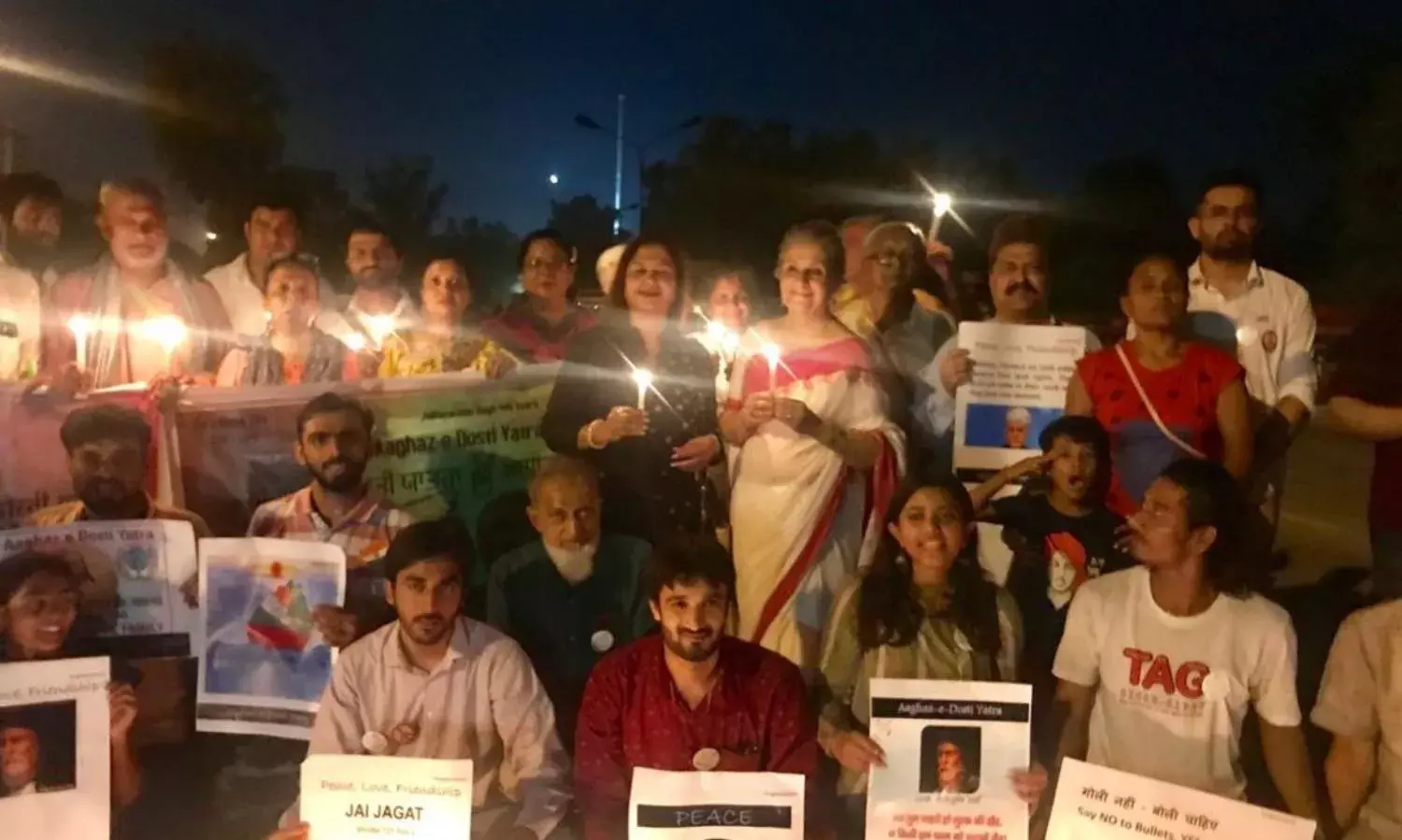A 100 Candles Light the Path to Peace
Where hearts meet

At the stroke of midnight 100 women and men stood at the India Pakistan border demanding peace. It was the night between August 14 and 15. Pakistan had just celebrated its Independence Day, India was about to begin hers.
Celebrations?
This was the 24th year since candle lighting began. This year also marked the worst mahaul ever between the two countries. Post abrogation of article 370 in Kashmir, Pakistan had taken strident measures against India. India had responded, blow for blow. In Gandhi’s words, the whole world was being blinded.
We had been filled with apprehension since August 5. Would the journey be stopped in its tracks? Peace activists on the other side who were planning to light candles at their Baab e Azadi to coincide with Indians on the Attari side, had received a red alert from their government. Even as we flagged off the Yatra from Mohini Giri’s Guild of Service there was more bravado than hope, at least in my heart.
The Aman Dosti Bus set out early morning on August 13 with 45 yatris, others were to join them from Panipat, which under Ram Mohan Rai has been the hub of the Yatra for many years. Two buses one Innova and 78 yatris set out on this journey of hope.
I was reminded of our Women’s Bus of Peace in 2000 where 43 of us led by Nirmala Deshpande and Mohini Giri set out for Lahore at the height of Kargil war. Our anthem were lines sung at Vinobha Bhave’s pad yatras:
Shanti ke sipahi chale kranti ke sipahi chale/ Le ke khair khwahi chale rokney tabahi chaley/ Shanti ke sipahi chale
Under the banner of Aghaz e Dosti, the Aman Dosti Bus carried Yatris from all over India. From 93 year old swatantra senani Haru Tai of Maharashtra to 7 year old Bhuvanesh, son of Deepak Kathuria of Haryana who had given his all to this Yatra, was the age range.
Men women, young from Karnataka, Telangana, Kerala, UP MP Rajasthan Maharashtra, the list is long. Their journey stretched over 20 hours because of several stops on the way. The idea was to spread the word of Dosti enroute among common janta of the countryside. Contrary to apprehension, given the media frenzy, the Yatris were welcomed everywhere with garlands, sweets, cold drinks and food. They held corner meetings and nukkad nataks. Their overwhelming peace constituency were women and men roadside labour, auto rickshaw drivers, farm labour, schoolchildren. Goli nahin boli, yudh nahin budh, jang nahin aman, they chanted along with the Yatris.
Amritsar was ready for them with open hearts and open arms. Naat Shaala a cultural hub of the city had once again opened its doors. The hall was packed with people from Amritsar, Ludhiana, Jalandhar and many other parts of Punjab.
Hind Pak Dosti Manch, nurtured by Kuldip Nayar until the last day of his life, had dedicated this event to the world’s greatest symbol of Peace whose 550 birth anniversary is being globally commemorated this year. The banner read Hind Pak Friendship Festival Dedicated to Guru Nanak Dev Ji.
Satnam Manak and Ramesh Yadav, Kuldip Nayar’s students of peace, who have held the candles with a steady hand despite many adverse winds steered the morning. Speakers like Kumar Ketkar Member Parliament, Siddarth Varadarajan Senior Editor, Jatin Desai, crusader for fish-workers on both sides of the border. Kamla Bhasin philosopher and activist, Prof Jagmohan historian from the Bhagat Singh family Ravi Nitesh youth peace icon and others spoke on ‘Indo Pak Relations and Guru Nanak Dev Ji’s Philosophy of Co existence'.
Prof Gogwani referred to Guru Nanak as Hindu ka Guru our Muslim ka Pir. Kashmir came up in every intervention. Satnam Manak appealed to keep democracy alive adding that Punjab is the land of sacrifice it will fight the battle.
Kamla Bhasin took the gender perspective saying that women are chinks in the walls that divide hearts and separate people.
There were 7 organisations whose names were inscribed on the banner. From this platform speaker after speaker spoke from the heart and the audience listened in rapt attention for four hours without a break. When the resolution was read in clear unequivocal voice by Satnam Manak, it was the audience who added a line condemning derogation of Kashmiri women by top leaders of the ruling party.
There were 17 organisations, most of them I know personally, behind the Aman Dosti Yatra. But the surprise for me was one name on the banner. SAFMA, a media organisation is led by Imtiaz Alam of Lahore. It was inscribed on the Conference banner. I knew that it were Kuldip and Imtiaz who had initiated this ceremony on the border 24 years ago as a contrast to the official ceremony on both sides, reflecting aggression and hate. But to have SAFMA upfront in these fearsome days! I salute my comrades.
The evening melted into Sufi music, mostly Punjabi, which began with Nusrat Fateh Ali Khan’s Allah Hu and ended with ‘Tu uthh ke jalade mombatiyan’ both sung by Sunny Saleem and brothers. Kuldip’s spirit hovered over the mehfil. Many eyes were moist.
Then a beautiful young boy made his debut singing punjabi nazms about Jallianwala Bagh; 100 years of unmitigated grief was reflected in his singing. Who is he? I asked. ‘Yakoob Gill’ simple, humble boy from our Pind. I suddenly thought he the namesake of Hazrat Yaqub, this boy was my much maligned Ganga Jamni tehzeeb.
Standing at a distance from zero line, a hundred people held up candles to Peace and to the comrades across the gates and beyond who were trapped in the imperatives of statecraft. I was standing with these people in the land of five rivers. I felt I was with my with my own people; my watan was also undivided Punjab. After many days I felt safe and hopeful.



